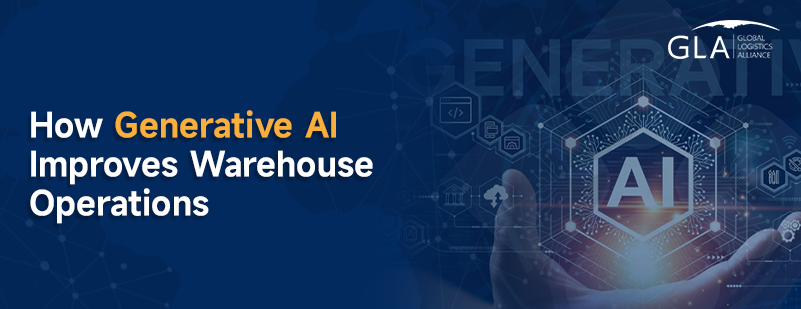Welcome to GLA! Leading the global logistics alliance.


Your location:Home > News > GLA New Product Categories
Time:2024-01-26 Publisher:Kevin Num:11954

Warehouse operations are the backbone of the supply chain, ensuring the seamless movement of products from manufacturers to consumers. However, these operations are not without their challenges, ranging from inventory management to pick-and-pack processes, equipment maintenance, and overall operational efficiency. In recent years, the emergence of generative AI has presented a transformative solution to address these challenges, promising to revolutionize the way warehouses operate.
Generative AI stands at the forefront of artificial intelligence, equipped with the capability to generate unique content or responses dynamically. Unlike traditional rule-based AI, generative AI utilizes machine learning to adapt and respond to data dynamically. This article delves into the application of generative AI to optimize various facets of warehouse operations.
Optimization of Inventory Management
Effective inventory management is crucial for warehouse operations, balancing the need for optimal stock levels with minimizing costs. Generative AI has emerged as a key player in transforming inventory management by offering accurate demand forecasting.
Generative AI algorithms leverage historical sales data, market trends, and other relevant variables to predict future demand accurately. This enables warehouses to optimize inventory levels, reducing carrying costs and mitigating the risk of stockouts. For example, a prominent e-commerce company implemented a generative AI system, resulting in a remarkable 20% reduction in excess inventory and a 15% improvement in order fulfillment rates.
Illustrative case studies further highlight the effectiveness of generative AI in inventory management. A global electronics retailer, for instance, utilized generative AI to forecast product demand. The system accurately predicted shifts in consumer preferences and market trends, enabling the company to proactively adjust inventory levels. As a result, the retailer experienced a 25% reduction in obsolete stock and a 30% increase in overall inventory turnover.
Enhancing Pick-and-Pack Processes
Efficient pick-and-pack processes are essential for minimizing order fulfillment times and ensuring customer satisfaction. Generative AI optimizes pick routes and packing processes by analyzing real-time data, including order volume, product locations, and traffic patterns within the warehouse.
By dynamically adjusting pick routes based on current conditions, generative AI ensures that warehouse staff can pick items in the most efficient sequence, reducing travel time and improving overall productivity. Real-life examples underscore the impact of generative AI on pick-and-pack operations. A logistics company, for instance, implemented generative AI to optimize picking routes, resulting in a notable 30% reduction in order processing time and a 20% increase in order accuracy.
In another instance, a fashion retailer improved packing processes using generative AI. The system analyzed order details, product dimensions, and packaging requirements to generate optimal packing configurations. As a result, the retailer achieved a 25% reduction in packaging waste and a 15% improvement in packing efficiency.
Predictive Maintenance and Equipment Optimization
Equipment breakdowns and maintenance-related downtime can significantly impact warehouse operations. Generative AI plays a crucial role in predicting equipment failures and optimizing maintenance schedules, leading to reduced downtime and cost savings.
Generative AI algorithms analyze sensor data from warehouse equipment to identify patterns indicative of potential failures. By leveraging machine learning, these systems predict equipment failures before they occur, allowing for proactive maintenance. A distribution center implemented generative AI for predictive maintenance on its conveyor systems, resulting in a substantial 40% reduction in unplanned downtime and a 25% decrease in maintenance costs.
Case studies across industries underscore the value of generative AI in equipment optimization. An automotive parts manufacturer utilized generative AI to optimize the maintenance schedules of its robotic assembly line. The system accurately predicted maintenance needs, allowing the manufacturer to perform preventive maintenance during scheduled downtimes. This approach led to a significant 30% reduction in production disruptions and a 20% increase in overall equipment efficiency.
Improving Overall Operational Efficiency
Generative AI can streamline various warehouse processes, resulting in a significant improvement in overall operational efficiency. From order processing to shipping and receiving, these systems analyze data in real-time, identify bottlenecks, and suggest optimizations.
For instance, a large distribution center implemented generative AI to optimize its order processing workflow. The system analyzed order details, inventory levels, and staffing availability to dynamically allocate resources and prioritize orders. This resulted in a remarkable 25% reduction in order processing times and a 15% improvement in order accuracy.
Statistical data supports the positive impact of generative AI on overall operational efficiency. A survey of warehouses that implemented generative AI solutions reported an average 18% improvement in order fulfillment rates, a 22% reduction in operational costs, and a 30% increase in overall productivity.
Conclusion
In conclusion, generative AI is proving to be a game-changer in warehouse operations, addressing challenges and unlocking new levels of efficiency. The ability of generative AI to optimize inventory management, enhance pick-and-pack processes, predict equipment failures, and improve overall operational efficiency is reshaping the industry.
As technology continues to evolve, the future potential of generative AI in the warehouse industry is vast. With ongoing advancements in machine learning and data analytics, generative AI systems will become even more sophisticated, providing warehouses with increasingly accurate insights and recommendations.
The implications of generative AI extend beyond operational efficiency, impacting customer satisfaction, cost savings, and sustainability. As more warehouses embrace this transformative technology, the industry is poised for a new era of efficiency, adaptability, and competitiveness. Generative AI is not just a tool for today's challenges; it is a catalyst for the future of warehouse operations.
Prev:The Future of Logistics Management and Why You Should Pay AttentionNext:Welcome! New Golden Member from Mexico ————Galgo Forwarding
Recommended Membership
Latest News